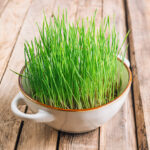by: November 2, 2024
 (NaturalHealth365) In the 1970s, wheatgrass was a staple among a small circle of health practitioners. At that time, only the most dedicated healers cultivated and juiced wheatgrass, recognizing its dense nutrient profile. Although its powerful potential in disease prevention, including cancer, wasn’t yet fully understood, wheatgrass quickly gained a reputation for supporting overall wellness.
(NaturalHealth365) In the 1970s, wheatgrass was a staple among a small circle of health practitioners. At that time, only the most dedicated healers cultivated and juiced wheatgrass, recognizing its dense nutrient profile. Although its powerful potential in disease prevention, including cancer, wasn’t yet fully understood, wheatgrass quickly gained a reputation for supporting overall wellness.
Here are three key reasons why incorporating wheatgrass into a daily routine may benefit those focused on healing and preventing cancer.
How wheatgrass can be a game-changer in cancer prevention
Wheatgrass is a remarkable addition to any health routine, especially when it comes to preventing cancer. Packed with nutrients, it can help strengthen the body’s natural defenses and support overall well-being.
Understanding what makes wheatgrass so beneficial is key for anyone wanting to improve their health and take proactive steps toward wellness.
Reason #1: Wheatgrass is packed with chlorophyll
The biggest nutritional plus for consuming wheatgrass every day has to do with its high chlorophyll content.
Chlorophyll gives plants their vibrant, bright green color – and it helps regulate many healing functions in the human body, including hormone balance, detoxification, blood clotting, and wound healing.
Chlorophyll is also a solid cancer-preventer for several reasons. First of all, it can help clean and oxygenate the blood. Remember that cancer cells need anaerobic, oxygen-deprived conditions to grow.
Secondly, according to many studies, the chlorophyll in wheatgrass helps reduce inflammation in the body. A study published in the journal Inflammation found that chlorophyll reduced the production of in vitro pro-inflammatory cytokines. Chronic systemic inflammation is a strong precursor for cancer.
Thirdly, and perhaps most importantly, chlorophyll is a powerful antioxidant that protects against many dangerous carcinogens in the environment and food. Dove-tailing on previous animal models that found chlorophyll to have a negative effect on “carcinogen bioavailability” (i.e., the amount of a cancer-causing substance that actually enters into circulation in the body), researchers at Linus Pauling Institute conducted a small human trial in 2009.
They found that in all of the volunteer subjects studied, ingesting chlorophyll rapidly blocked aflatoxin absorption, a mold toxin commonly found in commercial sources of corn and peanuts. A 2010 West Virginia University study also discovered that chlorophyll was protective against benzo[a]pyrene. This toxin comes primarily from tobacco smoke and grilled meats, which is linked to breast cancer in particular.
Finally, a study published in the international journal Tumour Biology found that chlorophyll can downregulate the communication pathways cancer cells need to grow.
Reason #2: Wheatgrass is a high-alkaline, nutrient-dense food
Wheatgrass is packed with over 100 essential nutrients (equivalent to about 2 pounds of greens per one “shot”).
This fact alone is probably the main reason why the people of ancient Mesopotamians grew it so abundantly over 5,000 years ago. Its quickly-absorbed nutritional quotient (when juiced) was certainly why health pioneer Ann Wigmore’s grandmother used it to heal her sickly granddaughter. Wigmore went on to found the Hippocrates Health Institute in Boston in the 1940s – where wheatgrass became a major part of her Living Foods Lifestyle.
Of the dozens of nutrients packed into one humble little wheatgrass blade, several have proven beneficial for breast health. These include selenium, vitamin D, Vitamins B6 and B12, magnesium, manganese, potassium, and zinc. It is also a natural source of calcium.
Reason #3: Wheatgrass may be a strong and safe alternative to some toxic drugs
Finally, chlorophyll has been studied as an alternative to Methotrexate (MTX), a toxic drug commonly used in conventional photodynamic cancer therapy. Researchers at a German University in Cairo targeted common breast cancer cells with light-activated chlorophyll. They found that “50% of MCF-7 tumor cell death (LC(50)) was reached by using a concentration of chlorophyll derivative that is 138 times lower than MTX.” There were also no side effects to chlorophyll use, whereas MXT can sometimes result in DNA damage.
Chlorophyll has also become a great adjunct to holistic cancer healing modalities. Clinics in Russia and elsewhere have used chlorophyll as a non-toxic delivery agent for Sono-Photo Dynamic Therapy (SPDT) since the 1990s.
Obtaining wheatgrass: Be mindful of the source
You can get a shot of wheatgrass at your local natural foods store or smoothie shop. If you do, however, be sure to get it from a quality establishment and watch out for mold. It is easy to grow wheatgrass on your own – if you have the right equipment. You can also investigate online organic growers who ship the juice flash-frozen right to your door.
Wheatgrass truly represents what it means for a substance to be a “superfood.” If you want to stay alkalized and cancer-free, consider adding it to your wellness regimen.
Sources for this article include:
No hay comentarios:
Publicar un comentario